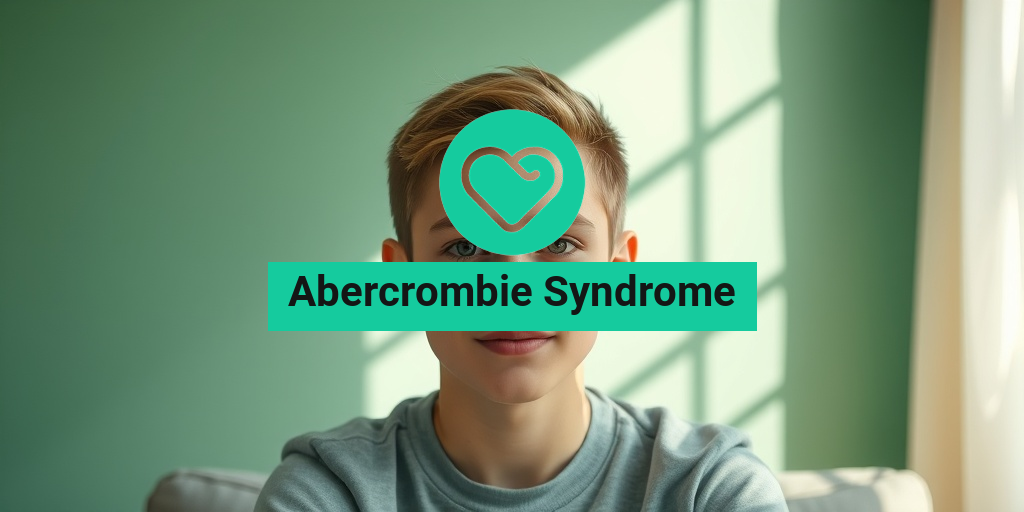What Is Abercrombie Syndrome?
Abercrombie Syndrome, also known as Abercrombie’s disease, is a rare genetic disorder that primarily affects the skin and hair. This condition is characterized by a unique set of symptoms that can significantly impact an individual’s quality of life. Abercrombie Syndrome is often associated with a deficiency in the production of certain proteins that are crucial for normal skin and hair development.
The syndrome is named after the renowned dermatologist who first described the condition. Although it is not widely known, understanding Abercrombie Syndrome is essential for those affected and their families. The condition can lead to various complications, making early diagnosis and management vital.
Causes of Abercrombie Syndrome
Abercrombie Syndrome is primarily caused by genetic mutations that affect the body’s ability to produce specific proteins. These proteins play a crucial role in the formation and maintenance of skin and hair follicles. The exact genetic mechanisms are still being studied, but researchers believe that both inherited and spontaneous mutations can contribute to the development of this syndrome.
Who Is Affected?
Abercrombie Syndrome can affect individuals of any age, but it is often diagnosed in childhood or adolescence. The prevalence of this condition is low, making it a rare diagnosis. Both males and females are equally affected, and the symptoms can vary widely among individuals.
Abercrombie Syndrome Symptoms
The symptoms of Abercrombie Syndrome can range from mild to severe and may include:
- Hypotrichosis: This refers to a significant reduction in hair growth, leading to sparse or absent hair on the scalp and body.
- Skin Abnormalities: Individuals may experience dry, flaky skin or other dermatological issues that can lead to discomfort.
- Hypopigmentation: Some people with Abercrombie Syndrome may have lighter skin or hair color due to a lack of melanin production.
- Increased Sensitivity: The skin may be more sensitive to environmental factors, leading to irritation or allergic reactions.
- Psychosocial Impact: The visible symptoms can lead to emotional distress, social anxiety, or low self-esteem, particularly in adolescents.
Recognizing the Symptoms
Recognizing the symptoms of Abercrombie Syndrome is crucial for early intervention. Parents and caregivers should be vigilant for signs of hair loss or unusual skin conditions in children. If you notice any of these symptoms, it is essential to consult a healthcare professional for a proper diagnosis and management plan.
Diagnosis and Treatment Options
Diagnosing Abercrombie Syndrome typically involves a thorough clinical examination and a review of the patient’s medical history. Genetic testing may also be recommended to confirm the diagnosis and identify specific mutations. While there is currently no cure for Abercrombie Syndrome, various treatment options can help manage symptoms and improve quality of life.
Some common treatment approaches include:
- Topical Treatments: Moisturizers and medicated creams can help alleviate skin dryness and irritation.
- Hair Restoration Therapies: Depending on the severity of hair loss, options such as topical minoxidil may be considered.
- Psychological Support: Counseling or support groups can be beneficial for individuals struggling with the emotional aspects of the syndrome.
For more comprehensive information and resources on managing Abercrombie Syndrome, consider visiting Yesil Health AI, where you can find evidence-based health answers tailored to your needs.
Living with Abercrombie Syndrome
Living with Abercrombie Syndrome can present challenges, but with the right support and treatment, individuals can lead fulfilling lives. It is essential to foster an environment of understanding and acceptance, both at home and in the community. Awareness and education about this rare condition can help reduce stigma and promote empathy.
In conclusion, Abercrombie Syndrome is a rare genetic disorder that affects skin and hair development. By recognizing the symptoms and seeking appropriate medical care, individuals can manage the condition effectively. Remember, you are not alone in this journey, and resources are available to help you navigate the challenges of Abercrombie Syndrome. 🌟

Causes of Abercrombie Syndrome
Abercrombie Syndrome, a rare genetic disorder, is primarily characterized by a combination of physical and developmental challenges. Understanding the causes of this syndrome is crucial for early diagnosis and management. Let’s delve into the key factors that contribute to the development of Abercrombie Syndrome.
Genetic Mutations
The primary cause of Abercrombie Syndrome is genetic mutations. These mutations can occur in specific genes responsible for normal development and function. While the exact genes involved are still being researched, it is believed that alterations in these genes disrupt the typical growth patterns, leading to the symptoms associated with the syndrome.
Inheritance Patterns
Abercrombie Syndrome can be inherited in various ways, depending on the specific genetic mutations involved. Some cases may follow an autosomal dominant pattern, meaning only one copy of the mutated gene from an affected parent can cause the syndrome in their offspring. Other cases may be autosomal recessive, requiring both parents to pass on a mutated gene for the child to be affected. Understanding these inheritance patterns is essential for families with a history of the syndrome.
Environmental Factors
While genetic factors play a significant role, environmental influences may also contribute to the development of Abercrombie Syndrome. Factors such as maternal health during pregnancy, exposure to certain medications, or toxins can potentially impact fetal development. Although research is ongoing, it is crucial for expectant mothers to maintain a healthy lifestyle and avoid harmful substances to reduce the risk of genetic disorders.
Risk Factors for Abercrombie Syndrome
Identifying the risk factors associated with Abercrombie Syndrome can help in understanding who may be more susceptible to this condition. Here are some of the key risk factors to consider:
Family History
A strong family history of genetic disorders can increase the likelihood of Abercrombie Syndrome. If there are known cases of the syndrome or other genetic conditions in the family, it is advisable to seek genetic counseling. This can provide valuable insights into the risks and implications for future pregnancies.
Parental Age
Research suggests that advanced parental age, particularly maternal age, may be a risk factor for genetic disorders, including Abercrombie Syndrome. Women over the age of 35 may have a higher chance of chromosomal abnormalities, which can lead to various syndromes. Therefore, it is essential for older parents to discuss potential risks with their healthcare providers.
Ethnicity
Some genetic disorders, including Abercrombie Syndrome, may have varying prevalence rates among different ethnic groups. Certain populations may carry specific genetic mutations at higher frequencies, increasing the risk of the syndrome. Understanding these ethnic predispositions can aid in early detection and intervention.
Previous Pregnancy Complications
Women who have experienced complications in previous pregnancies, such as miscarriages or stillbirths, may have an increased risk of having a child with Abercrombie Syndrome. These complications can sometimes indicate underlying genetic issues that could affect future pregnancies.
Genetic Carrier Status
Individuals who are carriers of specific genetic mutations may not show symptoms of Abercrombie Syndrome themselves but can pass the mutations to their children. Genetic testing can help identify carrier status, allowing families to make informed decisions regarding family planning.
In conclusion, understanding the causes and risk factors associated with Abercrombie Syndrome is vital for early diagnosis and effective management. By being aware of these elements, families can take proactive steps to ensure the best possible outcomes for affected individuals. 🌟

Diagnosing Abercrombie Syndrome
Diagnosing Abercrombie Syndrome can be a complex process, as it often involves a combination of clinical evaluation, patient history, and specific diagnostic tests. This rare genetic disorder primarily affects the skin and hair, leading to distinctive features that can help healthcare professionals identify it.
Clinical Evaluation
The first step in diagnosing Abercrombie Syndrome typically involves a thorough clinical evaluation by a dermatologist or geneticist. During this evaluation, the doctor will look for characteristic symptoms, which may include:
- Hypotrichosis: A significant reduction in hair density, particularly on the scalp.
- Skin Abnormalities: These may include dry, scaly patches or changes in pigmentation.
- Facial Features: Distinctive facial features may also be noted, which can vary from person to person.
Patient History
Gathering a detailed patient history is crucial. The healthcare provider will ask about:
- Family history of similar symptoms or genetic disorders.
- Onset of symptoms and any changes over time.
- Any other associated health issues.
This information can provide valuable insights into the likelihood of Abercrombie Syndrome and help rule out other conditions with similar presentations.
Genetic Testing
In many cases, genetic testing is recommended to confirm the diagnosis. This testing can identify specific mutations associated with Abercrombie Syndrome. A blood sample is typically taken, and the DNA is analyzed for known genetic markers. This step is essential, as it not only confirms the diagnosis but also helps in understanding the inheritance pattern of the syndrome.
Consultation with Specialists
Depending on the symptoms presented, the healthcare provider may refer the patient to specialists such as:
- Dermatologists: For skin-related issues.
- Genetic Counselors: To discuss the implications of genetic testing and family planning.
- Pediatricians: If the patient is a child, to monitor growth and development.
Overall, a comprehensive approach is essential for an accurate diagnosis of Abercrombie Syndrome, ensuring that all aspects of the patient’s health are considered.
Abercrombie Syndrome Treatment Options
While there is currently no cure for Abercrombie Syndrome, various treatment options can help manage symptoms and improve the quality of life for those affected. The treatment plan is often tailored to the individual’s specific symptoms and needs.
Topical Treatments
For skin-related symptoms, dermatologists may recommend topical treatments, which can include:
- Moisturizers: To alleviate dryness and improve skin texture.
- Corticosteroids: To reduce inflammation and irritation.
- Retinoids: To promote skin cell turnover and improve overall skin appearance.
These treatments can help manage the skin symptoms associated with Abercrombie Syndrome, making the skin more comfortable and less prone to complications.
Hair Restoration Options
For individuals experiencing hypotrichosis, hair restoration options may be explored. These can include:
- Minoxidil: A topical solution that may stimulate hair growth.
- Hair Transplant Surgery: In some cases, surgical options may be considered for more permanent solutions.
Consultation with a hair restoration specialist can provide insights into the most suitable options based on individual circumstances.
Psychosocial Support
Living with Abercrombie Syndrome can be challenging, both physically and emotionally. Therefore, psychosocial support is an essential component of treatment. This can include:
- Counseling: To help individuals cope with the emotional aspects of the syndrome.
- Support Groups: Connecting with others who have similar experiences can provide comfort and understanding.
Addressing the emotional and psychological impacts of Abercrombie Syndrome is crucial for overall well-being.
Regular Monitoring and Follow-Up
Regular follow-up appointments with healthcare providers are vital to monitor the progression of symptoms and adjust treatment plans as necessary. This ongoing care ensures that individuals receive the support they need throughout their lives.
In summary, while Abercrombie Syndrome presents unique challenges, a combination of medical treatments, psychosocial support, and regular monitoring can significantly enhance the quality of life for those affected. 🌟

Living with Abercrombie Syndrome
Abercrombie Syndrome, though rare, can significantly impact the lives of those affected. Understanding this condition is crucial for both patients and their families. In this section, we will explore the daily challenges faced by individuals living with Abercrombie Syndrome and the strategies that can help improve their quality of life.
Understanding Abercrombie Syndrome
Abercrombie Syndrome is a genetic disorder characterized by a range of symptoms, including hypotrichosis (reduced hair growth), hypohidrosis (decreased ability to sweat), and hypopigmentation (lighter skin and hair). These symptoms can lead to various physical and emotional challenges.
Daily Challenges
Living with Abercrombie Syndrome can present several daily challenges:
- Social Interactions: Individuals may feel self-conscious about their appearance, leading to anxiety in social situations.
- Heat Sensitivity: Due to hypohidrosis, those with Abercrombie Syndrome may struggle to regulate their body temperature, making hot weather particularly uncomfortable.
- Skin Care: The lighter skin and hair can be more susceptible to sunburn, necessitating diligent sun protection measures.
Strategies for Coping
While living with Abercrombie Syndrome can be challenging, there are several strategies that can help individuals manage their symptoms and improve their overall well-being:
- Support Groups: Connecting with others who have Abercrombie Syndrome can provide emotional support and practical advice.
- Therapeutic Interventions: Counseling or therapy can help individuals cope with the emotional aspects of living with a visible condition.
- Sun Protection: Using sunscreen and wearing protective clothing can help mitigate the risks associated with hypopigmentation.
Embracing Individuality
It’s essential for individuals with Abercrombie Syndrome to embrace their uniqueness. Celebrating differences can foster a positive self-image and encourage others to appreciate diversity. Engaging in activities that highlight personal strengths and talents can also boost confidence and self-esteem. 🌟
Future Research on Abercrombie Syndrome
The field of genetic research is rapidly evolving, and Abercrombie Syndrome is no exception. Ongoing studies aim to deepen our understanding of this condition, paving the way for improved treatments and support for those affected.
Current Research Trends
Researchers are focusing on several key areas to advance knowledge about Abercrombie Syndrome:
- Genetic Studies: Identifying the specific genes involved in Abercrombie Syndrome can lead to better diagnostic tools and potential therapies.
- Symptom Management: Investigating effective treatments for managing symptoms, such as hair loss and heat intolerance, is a priority.
- Quality of Life Assessments: Understanding how Abercrombie Syndrome affects daily living can inform support services and interventions.
Potential Breakthroughs
As research progresses, several potential breakthroughs could emerge:
- Gene Therapy: Advances in gene editing technologies may offer new avenues for treating genetic disorders like Abercrombie Syndrome.
- Personalized Medicine: Tailoring treatments based on individual genetic profiles could enhance the effectiveness of therapies.
- Community Awareness: Increased awareness and understanding of Abercrombie Syndrome can lead to better support systems and resources for affected individuals.
Conclusion
While Abercrombie Syndrome presents unique challenges, ongoing research holds promise for the future. By fostering a supportive community and advancing scientific understanding, we can improve the lives of those affected by this condition. 🌈

Frequently Asked Questions about Abercrombie Syndrome
What is Abercrombie Syndrome?
Abercrombie Syndrome is a rare genetic disorder characterized by specific physical features and developmental challenges. It primarily affects the skin and hair, leading to distinctive appearances in affected individuals.
What are the symptoms of Abercrombie Syndrome?
Individuals with Abercrombie Syndrome may exhibit a range of symptoms, including:
- Hypopigmented skin
- Sparse hair growth
- Facial abnormalities
- Potential developmental delays
How is Abercrombie Syndrome diagnosed?
Diagnosis typically involves a thorough physical examination and a review of the patient’s medical history. Genetic testing may also be conducted to confirm the presence of specific mutations associated with Abercrombie Syndrome.
Is there a treatment for Abercrombie Syndrome?
Currently, there is no cure for Abercrombie Syndrome. Treatment focuses on managing symptoms and may include:
- Physical therapy for developmental delays
- Cosmetic interventions for skin and hair issues
- Supportive care to enhance quality of life
Can Abercrombie Syndrome be inherited?
Yes, Abercrombie Syndrome can be inherited in an autosomal recessive manner, meaning that both parents must carry the gene mutation for a child to be affected. Genetic counseling is recommended for families with a history of the syndrome.
Are there any support groups for Abercrombie Syndrome?
Yes, there are various support groups and online communities where individuals and families affected by Abercrombie Syndrome can connect, share experiences, and access resources. These groups can provide valuable emotional support and information.
What is the prognosis for individuals with Abercrombie Syndrome?
The prognosis for individuals with Abercrombie Syndrome varies widely depending on the severity of symptoms and associated complications. Early intervention and supportive care can significantly improve outcomes and quality of life.
Where can I find more information about Abercrombie Syndrome?
For more information, consider visiting reputable medical websites, genetic disorder organizations, or consulting with healthcare professionals who specialize in genetic conditions.




